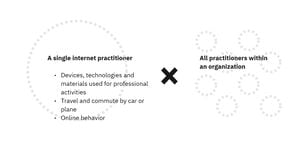
Measuring personal carbon emissions lie at the heart of measuring environmental impact and stand as a useful metric for understanding the relationship between our lifestyle and the planet.
Some criticize this metric because it is used as a strategy to shift the blame from oil corporations to consumers[1] or to make individuals you feel guilty about their lifestyle.[2] However, it's may also be argued that oil demand drives oil corporations (and not the other way round). Furthermore, there's value in understanding how freelance tech workers contribute to emissions in their own countries and abroad.
We will start by measuring your everyday footprint to show you how tech practitioners have much more agency than many people believe.
Incentives for outsourcing digital labor[edit | edit source]
The shift of work towards outsourced international labor is part of a larger trend incentivized by reducing organizational costs, given that outsourced labor can save thousands of dollars per worker compared to hiring from the local workforce.[3] But these economic incentives also carry environmental implications. For example:
- Reducing the visible environmental accountability. Organizations do not need to disclose the carbon footprint of their outsourced emissions, which means that they can make their real emissions invisible by hiring services overseas.
- Some environmental regulations such as carbon taxes can cost a lot of money. This incentivizes companies to outsource their carbon footprint elsewhere.[4]
Why measuring is important[edit | edit source]
The goal of measuring your carbon footprint goes beyond asking you to walk to work or reducing your Internet use. Instead, consider it from two perspectives that relate you as part of a path to "environmental agency", or in other words, the ability to make decisions that make a difference.
Human-centered perspective[edit | edit source]
The first is that as you think about your own footprint, you are able to wear the end users' shoes. Many of the decisions you and your peers make about products, services and policies will affect how users browse the web, what technologies they adopt or what devices they purchase. Take web design, for instance. Have you ever browsed the web or an app using an old phone, only to find that the experience is terrible? Many of these are developed by teams who renew their devices continuously and might not notice bugs present only in older hardware, similar to how urban designers who never walk may not be good at designing walkable streets. This is because your daily routine makes a part of how you design for others. Here's a satirical example of web design for simplicity.[5]
Estimate your footprint using a calculator:
- Use the secondary tab to estimate the footprint of your office equipment (laptops, electronics, clothes, paper-based products).
- Use the house tab to estimate your energy usage during work hours. If you live alone, you can consider measuring your energy usage with your home meter or using another tool.
Horizontal leadership[edit | edit source]
The second one is that your small decisions can influence your peers and how you work. Examples of these are:
- The web services you decide to use for collaboration
- How often your team agrees to meet in person (especially if this requires flying overseas)
- How much you drive for work-related activities such as going to a coworking space or to meet potential clients, or whether a conference is to be held in-person or online. An interesting example of this is the impact that traveling to academic conferences has on the environment.
Estimate your footprint using a calculator:
- Use the car tab and estimate your footprint by considering how much you use your car for work: commuting to the office, visiting clients, or in-person meetings.
- Use the flights tab to estimate your usual flights for work and professional conferences.
Vertical leadership[edit | edit source]
Learning to view your work in terms of emissions is a good starting point as you start thinking of ways to influence your work at levels beyond the personal. Reducing your personal footprint is good, but practitioners have greater power than that.
- For your browser activity, you can use The Shift Project's excellent Carbonanalyser browser extension.
- Do you use a cryptocurrency wallet as part of your work? You can calculate its carbon footprint using carbon.fyi.
- If you use Zoom for videoconferencing, estimate your emissions with this neat tool.[6]
See also[edit | edit source]
- Energy Conservation with Open Source Ad Blockers is a great paper that shows how the collective use of ad blockers can reduce the Internet's carbon footprint.
- Air travel in academia is a study that estimates the emissions associated with academic conferences.
- How to reduce your carbon footprint is a general guide aimed for everyone, not just tech practitioners
References[edit | edit source]
- ↑ Solnit, R. (2021, August 23). Big oil coined 'carbon footprints' to blame us for their greed. Keep them on the hook. The Guardian. https://www.theguardian.com/commentisfree/2021/aug/23/big-oil-coined-carbon-footprints-to-blame-us-for-their-greed-keep-them-on-the-hook
- ↑ Mallett, R. K., Melchiori, K. J., & Strickroth, T. (2013). Self-Confrontation via a Carbon Footprint Calculator Increases Guilt and Support for a Proenvironmental Group. Ecopsychology, 5(1), 9–16. https://doi.org/10.1089/eco.2012.0067
- ↑ Iyer, N. (2021, August 31). Remote work risks exploiting workers in low-income countries. Quartz Africa. https://qz.com/africa/2053741/remote-work-risks-exploiting-workers-in-low-income-countries/
- ↑ Yang, Y., Goodarzi, S., Jabbarzadeh, A., & Fahimnia, B. (2022). In-house production and outsourcing under different emissions reduction regulations: An equilibrium decision model for global supply chains. Transportation Research Part E: Logistics and Transportation Review, 157, 102446. https://doi.org/10.1016/j.tre.2021.102446
- ↑ Smith, B. (n.d.). Motherfucking Website. Retrieved May 19, 2022, from https://motherfuckingwebsite.com/
- ↑ Mytton, D. (2020, November 16). Zoom, video conferencing, energy, and emissions. David Mytton. https://davidmytton.blog/zoom-video-conferencing-energy-and-emissions/